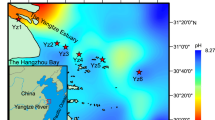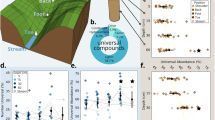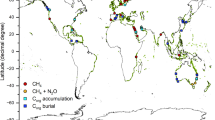Abstract
The production of artificial fertilizers, fossil fuel use and leguminous agriculture worldwide has increased the amount of reactive nitrogen in the natural environment by an order of magnitude since the Industrial Revolution1. This reorganization of the nitrogen cycle has led to an increase in food production2, but increasingly causes a number of environmental problems1,3. One such problem is the accumulation of nitrate in both freshwater and coastal marine ecosystems. Here we establish that ecosystem nitrate accrual exhibits consistent and negative nonlinear correlations with organic carbon availability along a hydrologic continuum from soils, through freshwater systems and coastal margins, to the open ocean. The trend also prevails in ecosystems subject to substantial human alteration. Across this diversity of environments, we find evidence that resource stoichiometry (organic carbon:nitrate) strongly influences nitrate accumulation by regulating a suite of microbial processes that couple dissolved organic carbon and nitrate cycling. With the help of a meta-analysis we show that heterotrophic microbes maintain low nitrate concentrations when organic carbon:nitrate ratios match the stoichiometric demands of microbial anabolism. When resource ratios drop below the minimum carbon:nitrogen ratio of microbial biomass4, however, the onset of carbon limitation appears to drive rapid nitrate accrual, which may then be further enhanced by nitrification. At low organic carbon:nitrate ratios, denitrification appears to constrain the extent of nitrate accretion, once organic carbon and nitrate availability approach the 1:1 stoichiometry5 of this catabolic process. Collectively, these microbial processes express themselves on local to global scales by restricting the threshold ratios underlying nitrate accrual to a constrained stoichiometric window. Our findings indicate that ecological stoichiometry can help explain the fate of nitrate across disparate environments and in the face of human disturbance.
This is a preview of subscription content, access via your institution
Access options
Subscribe to this journal
Receive 51 print issues and online access
$199.00 per year
only $3.90 per issue
Buy this article
- Purchase on Springer Link
- Instant access to full article PDF
Prices may be subject to local taxes which are calculated during checkout


Similar content being viewed by others
References
Galloway, J. N. et al. Transformation of the nitrogen cycle: recent trends, questions, and potential solutions. Science 320, 889–892 (2008)
Smil, V. Nitrogen in crop production: an account of global flows. Glob. Biogeochem. Cycles 13, 647–662 (1999)
Vitousek, P. M., Mooney, H. A., Lubchenco, J. & Melillo, J. M. Human domination of Earth’s ecosystems. Science 277, 494–499 (1997)
Sterner, R. W. & Elser, J. J. Ecological Stoichiometry: The Biology of Elements from Molecules to the Biosphere (Princeton University Press, 2002)
Richards, F. A. in Chemical Oceanography (eds Riley, J. P. & Skirrow, G.) Vol. 1, 611–645 (Academic Press, 1965)
Vitousek, P. M. & Howarth, R. W. Nitrogen limitation on land and sea: how can it occur. Biogeochemistry 13, 87–115 (1991)
Mulholland, P. J. et al. Stream denitrification across biomes and its response to anthropogenic nitrate loading. Nature 452, 202–205 (2008)
Barnes, R. T. & Raymond, P. A. Land use controls on the delivery, processing, and removal of nitrogen from small watersheds: insights from the dual isotopic composition of stream nitrate. Ecol. Appl 10.1890/08-1328 (in the press)
Arango, C. P. & Tank, J. L. Land use influences the spatiotemporal controls in nitrification and denitrification in headwater streams. J. N. Am. Benthol. Soc. 27, 90–107 (2008)
Bohlke, J. K. et al. Multi-scale measurements and modeling of denitrification in streams with varying flow and nitrate concentration in the upper Mississippi River basin, USA. Biogeochemistry 93, 117–141 (2009)
Hungate, B. A., Dukes, J. S., Shaw, M. R., Luo, Y. Q. & Field, C. B. Nitrogen and climate change. Science 302, 1512–1513 (2003)
Manzoni, S., Trofymow, J. A., Jackson, R. B. & Porporato, A. Stoichiometric controls on carbon, nitrogen, and phosphorus dynamics in decomposing litter. Ecol. Monogr. 80, 89–106 (2010)
Hill, A. R., Devito, K. J., Campagnolo, S. & Sanmugdas, K. Subsurface denitrification in a forest riparian zone: interactions between hydrology and supplies of nitrate and organic carbon. Biogeochemistry 51, 193–223 (2000)
Hedin, L. O. et al. Thermodynamic constraints on nitrogen transformations and other biogeochemical processes at soil-stream interfaces. Ecology 79, 684–703 (1998)
Goodale, C. L., Aber, J. D., Vitousek, P. M. & McDowell, W. H. Long-term decreases in stream nitrate: successional causes unlikely; possible links to DOC? Ecosystems 8, 334–337 (2005)
Evans, C. D. et al. Evidence that soil carbon pool determines susceptibility of semi-natural ecosystems to elevated nitrogen leaching. Ecosystems 9, 453–462 (2006)
Monteith, D. T. et al. Dissolved organic carbon trends resulting from changes in atmospheric deposition chemistry. Nature 450, 537–540 (2007)
Sarmiento, J. L. & Gruber, N. Ocean Biogeochemical Dynamics (Princeton University Press, 2006)
McGroddy, M. E., Daufresne, T. & Hedin, L. O. Scaling of C:N:P stoichiometry in forests worldwide: implications of terrestrial Redfield-type ratios. Ecology 85, 2390–2401 (2004)
Cleveland, C. C. & Liptzin, D. C:N:P stoichiometry in soil: is there a “Redfield ratio” for the microbial biomass? Biogeochemistry 85, 235–252 (2007)
Anderson, T. R., Hessen, D. O., Elser, J. J., & Urabe, J. Metabolic stoichiometry and the fate of excess carbon and nutrients in consumers. Am. Nat. 165, 1–15 (2005)
Apple, J. K. & del Giorgio, P. A. Organic substrate quality as the link between bacterioplankton carbon demand and growth efficiency in a temperate salt-marsh estuary. Multidisc. J. Microb. Ecol. 1, 729–742 (2007)
Jahnke, R. A. & Craven, D. B. Quantifying the role of hetertrophic bacteria in the carbon cycle: A need for respiration rate measurements. Limnol. Oceanogr. 40, 436–441 (1995)
del Giorgio, P. A. & Cole, J. J. Bacterial growth efficiency in natural aquatic systems. Annu. Rev. Ecol. Syst. 29, 503–541 (1998)
Tezuka, Y. Bacterial regeneration of ammonium and phosphate as affected by the carbon: nitrogen: phosphorus ratio of organic substrates. Microb. Ecol. 19, 227–238 (1990)
Mulholland, M. R. & Lomas, M. W. in Nitrogen In The Marine Environment (eds Capone, D. et al.) 303–361 (Academic Press, 2008)
Perakis, S. S. & Hedin, L. O. Nitrogen loss from unpolluted South American forests mainly via dissolved organic compounds. Nature 415, 416–419 (2002)
Raymond, P. A. & Bauer, J. E. Use of 14C and 13C natural abundances for evaluating riverine, estuarine, and coastal DOC and POC sources and cycling: a review and synthesis. Org. Geochem. 32, 469–485 (2001)
Cebrian, J. Patterns in the fate of production in plant communities. Am. Nat. 154, 449–468 (1999)
Allen, A. P. & Gillooly, J. F. Towards an integration of ecological stoichiometry and the metabolic theory of ecology to better understand nutrient cycling. Ecol. Lett. 12, 369–384 (2009)
Acknowledgements
We thank N. Fierer, D. McKnight, J. Neff, W. Wieder and P. Vitousek for their contributions to the ideas and text reflected here, and R. Cory and R. Jaffe for unpublished data. We also thank all the organizations, institutions, collaborative projects and scientists that provided unpublished data via online repositories, without which this analysis would be impossible. We are particularly grateful for the contributions made by scientists affiliated with the US LTER network and the JGOFS/BCO-DMO; see a detailed list of data sets, associated Principal Investigators and access information in the Supplementary Information Notes.
Author Contributions P.G.T. conceived the project, gathered the requisite data, and performed statistical analyses. P.G.T and A.R.T. developed the conceptual model, interpreted the empirical findings, and wrote the manuscript.
Author information
Authors and Affiliations
Corresponding author
Ethics declarations
Competing interests
The authors declare no competing financial interests.
Supplementary information
Supplementary Information
This file contains Supplementary Figures S1-S6 with legends, a Supplementary Discussion, Supplementary Tables S1-S6 and Supplementary References and Data Lists. (PDF 3104 kb)
PowerPoint slides
Rights and permissions
About this article
Cite this article
Taylor, P., Townsend, A. Stoichiometric control of organic carbon–nitrate relationships from soils to the sea. Nature 464, 1178–1181 (2010). https://doi.org/10.1038/nature08985
Received:
Accepted:
Issue Date:
DOI: https://doi.org/10.1038/nature08985
This article is cited by
-
Consistent stoichiometric long-term relationships between nutrients and chlorophyll-a across shallow lakes
Nature Communications (2024)
-
Longitudinal stream synoptic (LSS) monitoring to evaluate water quality in restored streams
Environmental Monitoring and Assessment (2024)
-
Allochthonous versus autochthonous carbon subsidies in small river food webs depend on seasonality and riparian tree species
Aquatic Sciences (2024)
-
Climate change and cropland management compromise soil integrity and multifunctionality
Communications Earth & Environment (2023)
-
Ecological Stoichiometry of Soil Carbon, Nitrogen and Phosphorus in Reclaimed Farmland in Coal Mining Subsidence Area
Journal of Soil Science and Plant Nutrition (2023)
Comments
By submitting a comment you agree to abide by our Terms and Community Guidelines. If you find something abusive or that does not comply with our terms or guidelines please flag it as inappropriate.



